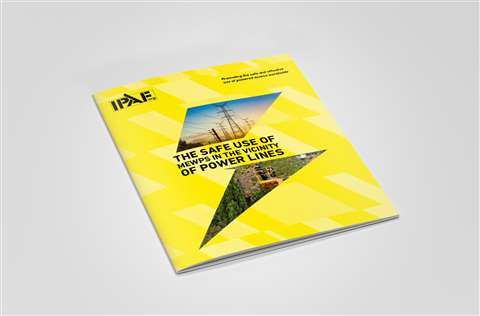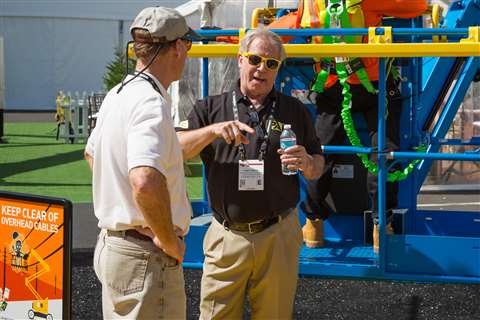IPAF power line safety guidance released
March 16, 2023
Comprehensive new guidance outlining key principles and ways to reduce risks when using MEWPs in the vicinity of power lines has been launched by the International Powered Access Federation (IPAF), as part of its High Voltage! targeted global safety campaign, at ConExpo, in Las Vegas, US.
 PIC: IPAF
PIC: IPAF
The new guidance document, entitled Safe Use of MEWPs in the Vicinity of Power Lines, aims to help to reduce electrocution and electric shock incidents. It has been developed by IPAF in collaboration with the IPAF International Safety Committee (ISC) and supporting members and is available to view or download initially in English.
After being launched officially at Conexpo, and following industry review and consideration of any feedback, the document will be made available in other languages and region-specific versions.
The document can be viewed and downloaded free of charge in digital format and is also available print-ready, allowing organisations to produce co-branded hard copies as required. Brian Parker, IPAF’s head of safety & technical, said, “By analysing data from the past ten years of accident reporting via IPAF’s portal, it’s evident that incidents involving electrocutions and electric shocks have notably increased since 2015. One standout statistic is that reported incidents of electrocution are nearly always fatal.
“Working in the vicinity of energised power lines can expose workers to health and safety risks including death by electrocution or electric shock. If a MEWP or its occupants contact energised power lines it can cause instant death, electric shock or other injuries caused directly or indirectly by electricity. Equally serious can be the effect of electricity arcing from the power line to a MEWP and its occupants.
“As with all common causes of accidents involving MEWPs, workplace safety culture and behaviour can play a big part in reducing the number of incidents.”
IPAF’s Safe Use of MEWPs in the Vicinity of Power Lines guidance aims to:
- Provide information for those who plan and manage MEWP operations.
- Provide information on the main causes of electrocutions with power lines.
- Raise awareness to the hazards and risks in working in close proximity to power lines.
- Provide information on the industry sectors where electrocutions and electric shocks occur.
- Identify risk control measures and Safe System of Work (SSoW) to implement and reduce the number of incidents occurring.
- Provide general global guidance for those who undertake tasks to prevent incidents occurring.
 Tony Groat, IPAF, North America, Regional Manager
Tony Groat, IPAF, North America, Regional Manager
Key points in the guidance:
- Plan thoroughly – look out and around for power lines in the work area. Conduct a site survey and risk assessment ensuring an SSoW is completed. Correct machine selection is critical. If power lines are in your work area contact the Energy Supply Authority (ESA) before work commences. Ensure operators are briefed prior to work commencing and that they are made aware of any power lines in the vicinity.
- Ensure operators are trained – anyone involved in the safe use of MEWPs must be properly trained on the type of MEWP they are using and must receive machine-specific familiarisation. Managers must ensure MEWP operators, supervisors and spotters are briefed on the SSoW.
- Stay outside exclusion zones – an exclusion zone is the prescribed safety envelope around live electric power lines. You must not operate a MEWP where there is potential for any part of it to enter an exclusion zone. Distances for exclusion zones can vary; these must be obtained from the relevant ESA.
- Know your rescue plan – if someone has been electrocuted by arcing of electricity or has been in contact with a power line, call the emergency services immediately and call the ESA to have the power turned off and the lines isolated. Observe the Stay, Call, Wait protocol.
Peter Douglas, CEO & MD of IPAF, commented,“This is a comprehensive new document and I trust the powered access industry will find it useful in planning and conducting work at height in the vicinity of power lines. Our accident data shows there is a particular prevalence of this type of incident in the US, so to launch the latest IPAF global safety campaign here at Conexpo is ideal.
“As with last year’s Don’t Fall For It! IPAF global safety campaign, we really hope High Voltage! can help to shift the dial on the most common types of safety incidents involving powered access. This is a challenge that affects all of us in the industry, and we have a collective responsibility to act.”
Visit www.ipaf.org/resources to view or download the new IPAF Safe Use of MEWPs
STAY CONNECTED



Receive the information you need when you need it through our world-leading magazines, newsletters and daily briefings.
CONNECT WITH THE TEAM








